List of Best Goat For Meat and Milk with Comparison and Information about their appearance, behavior, origin, etc.
Choosing the best goat breed is the key to a successful farming business. Although, they are the traditional animals for milk and meat production. If compared with other small farm animals, these animals are the friendliest, easiest to grow, and most profitable.
However, success in the animal farm business is highly dependent on picking a suitable breed in the first place.
Top 10 Goat Breeds For Meat Production
| Breed Name | Appearance | Weight (Adult) | Milk per day |
|---|---|---|---|
| Boer | Large, muscular white body, redhead and blaze. | Bulk: 240 to 300 pounds, Doe: 200 to 225 pounds. | 2 to 3 liters |
| Kalahari Red | Fairly new to the United States, one of the hardiest of breeds with a red coat color. | Bulk: 250 to 300 pounds, Doe: 165 to 220 pounds. | 2 1/4 to 3 liters |
| Kiko | Large in size, Most goats are of white color, and both bucks and do usually have horns. | Bulk: 250 to 300 pounds, Doe: 100 to 180 pounds. | 0.5 to 1 litter |
| Spanish Goats | Black and white, others have different shades of brown, have horns. | Bulk: 200 to 250 pounds, Doe: 100 to 150 pounds. | 0.5 liters |
| Savanna | Large framed, well-muscled, have white coats, skin, horns, and hooves have black pigmentation. | Bulk: 200-250 pounds, Doe: 125 to 200 pounds. | N/A |
| Rangeland Goat | Tall and wide, have short hair and medium-sized hanging ears. | 50 to 100 pounds | N/A |
| Tennessee Fainting Goat | Common fainting goat is black and white, stocky, with obvious width for height. | Bulk: 60 -200 pounds, Doe: 50 to 150 pounds. | 2.5 to 3.8 liters |
| Anglo-Nubian | Usually black, long, wide drooping ears, large eyes, and wide forehead. | Bulk: 100 to 300pounds, Doe: 80 to 240 pounds. | 200 ml to 1.2 liters |
| Black Bengal | Usually black, small in size but strong body structure, horns are small and legs are short. | Bulk: 55 to 65 pounds, Doe: 40 to 55 pounds. | 400 ml to 1 liter |
| Pygmy | Small, cobby, and compact, has horns, a short tail, and straighter hair. | Bulk: 40 to 60 pounds, Doe: 35 to 50 pounds. | 900 ml to 2 liters |
Best Goat Breeds for Beginners
Goats are one of the most common domestic animals around the glove. Like cows, they’re famous for their milk and meat. Still, being adaptable to any weather people prefer goats not only for dairy and meat but also as a pet.
But in most cases, people nurture goats for milk and meat. Since goat milk is more nutritious than other kinds of milk and meat has great market demand. Thinking of all that profit most people take it as a profession.
As there are over 300 breeds of goats around the world people are picky about the goats they’ll keep.
Cause the whole procedure is dependable on the breed of the goat. If you choose the wrong breed you will be unable to reach your target even if you provided your breed with every single requirement.
So make sure to choose the right breed of goat as they play a crucial role in your business or farm.
Selecting the right breeds is pretty much difficult for newbies and starters as there are so many varieties to select from.
For example, individuals of a slow-growing breed grow fast than individuals within a fast-growing breed. Similarly, some individuals of a low milk-yielding breed will provide more milk than individuals within a high milk-yielding breed.
Alpine Goat – Best Goat For Milk Production
- Known for: High-quality Milk.
- Varieties: Alpine polychrome, American Alpine, French Alpine
- Gestation Period: 145-155 days.
- Suitable For: Commercial and on small farms.
- Reared In: USA, India, Philippines, Malaysia, West Indies, and many.

Alpines mainly originated from the french alps. They come in various colors the size of medium to large. They’re short-haired and have upright ears. Female alpines weigh 135 pounds with 30 inches in the withers whereas males weigh 170 pounds with 34-40 inches in the withers. Alpines can thrive in any climate and are great milk producers.
They produce up to 2 gallons of milk per day making them one of the highest milk-producing breeds. For their milk-producing rate, they’re also known as ‘Alpine Dairy Goats’.
Boer Goat – Most profitable Meat Goat
- Known for: The largest and fast-growing goat breed. Best Goat for Meat.
- Gestation Period: 148 to 152 days.
- Suitable For: Commercial and on small farms.
- Reared In- the USA, Africa especially (Zimbabwe, Nigeria, Uganda), South Africa, and many.

This breed was derived from South Africa. They are mainly recognized by the white bodies and redheads with necks.
Both does and bucks have straight tails with strong and upright legs. The skin folds on the neck of the bucks are more desirable than do. They have downward medium-sized ears.
This breed is the largest of the goat breeds.
Bucks weigh 200-300 pounds whereas mature do 190-230 pounds. They are adaptive to any kind of environment. They have high fertility, great carcass quality, and a rapid growth rate. Boer is fostered for meat purposes only. As this breed has a great growth rate, raising this breed can boost one’s business quickly.
Anglo-Nubian Goat – Best for Both Milk and Meat
- Known for: British breed of domestic goat. The best goat for both milk and meat.
- Gestation Period: 149 to 152 days.
- Suitable For: Commercial and on small farms.
- Reared In- 60+ countries including Africa, West Indies, and the Indian subcontinent.
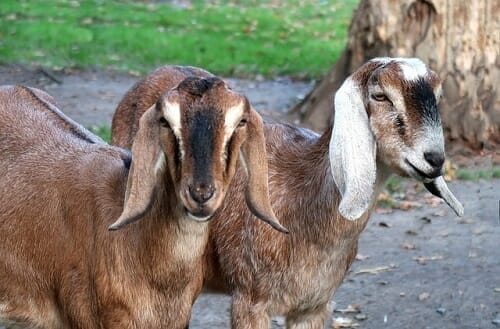
This kind originated from England. But some consider them a goat of mixed European, Asian, and African origin. The head of this breed makes them distinguished from other breeds. Although one can easily recognize them with their long, floppy, and pendulous ears.
The hair is short and glossy. Nubian bucks weigh 175 pounds with 35 inches in the height whereas does weigh 135 pounds with 30 inches in height.
Any color or, pattern is acceptable for this breed. The breeding season for the Nubian is long. Goats of the Nubian breed are sturdy and can live in very warm weather due to their middle eastern heritage. In terms of milk, the Nubian breed is a bit leg behind breeds like Pygmy, Boer, and Nigerian Dwarf.
Cause the milk from these breeds contains approximately 6-10% of butterfat and protein whereas the Nubian has only 5% of that. Still, the milk from the Nubian breed contains higher fat content which is widely used in making cheese. Besides this breed is also used for meat production. So if you think in a way nurturing this breed is of great benefit.
American Lamancha:
- Known for: The most distinctive goat breed. Best Goat for high milk production.
- Other names: Lamancha or LaMancha.
- Gestation Period: 150 to 155 days.
- Suitable For: Commercial and on small farms.
- Reared In: USA, Africa especially (Zimbabwe, Nigeria, Uganda), South Africa, and many.
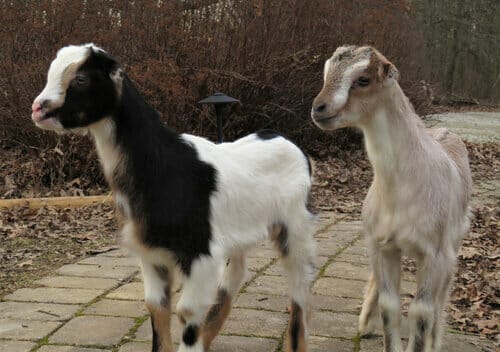
This type originated in Spain. Males weigh 155 pounds and 30 inches tall whereas females weigh 130 pounds and 28 inches tall. This breed can be easily recognized by its extremely short ear. Their ears are so small that some people call them “Earless Goats”.
There are two types of ears in this breed- gopher & elf ear. But these goats are so unyielding that they can endure any kind of hardship and still produce. This breed is famous for its milk as it contains butterfat and high protein.
The most advantageous thing about this breed is they can be milked without freshening for two years. These goats are cooperative, loveable, and gentle so it’s easier to look after them. This is a block of text. Double-click this text to edit it.
Myotonic Goat – Best for Meat Production
- Known for: High quality meats, though they are also raised milk production
- Other names: Fainting goat, Tennessee fainting goat, Wooden leg, Stiff leg.
- Gestation Period: 150 days.
- Suitable For: Small commercial farm and rear as a pet.
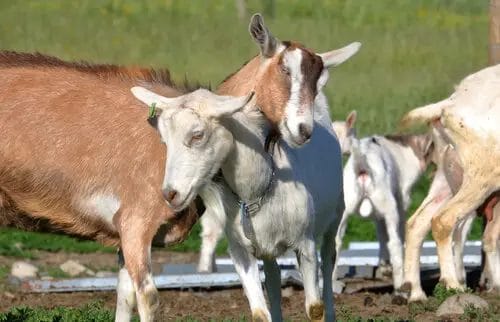
This breed was first discovered in Tennessee. They were named after the term myotonia congenita which causes stiffness and fainting effect. And for that reason this type is also known as Tennessee fainting goats, wooden legs, stiff-leg, nervous, or scared goats. They can be recognized specifically by their stiffness. They are dark in color but there is a lot of variety in color in this breed.
They have medium-sized horizontally held ears with horns on the head. Although some of the goats may not have horns. Their hair coating varies from small and smooth, to very long and furry They are friendly, loyal, calm, self-contained, and adaptable. As they are no heavy jumpers it easier to keep fenced in. But on the other hand, it makes them easier targets for the predators.
A regular myotonic goat weighs 200 pounds whereas smaller ones are 80 to 100 pounds. The myotonic breed is heavily muscled and for their muscular body structure, they are mainly raised for only meat.
Another reason for nurturing them for only meat is they have more muscle for their weight than other goats. Their meat is one of the top in quality. Their meat is mainly admired for its taste and tenderness. Even though this breed is only for meat production but does provide a great amount of milk.
Nigerian Dwarf Goat – Good for Milk & Grow as Pet
- Known for: American breed of dwarf goat. These miniature goats are best for milk production.
- Gestation Period: 150 to 155 days.
- Suitable For: Small farms (small dairy goats).
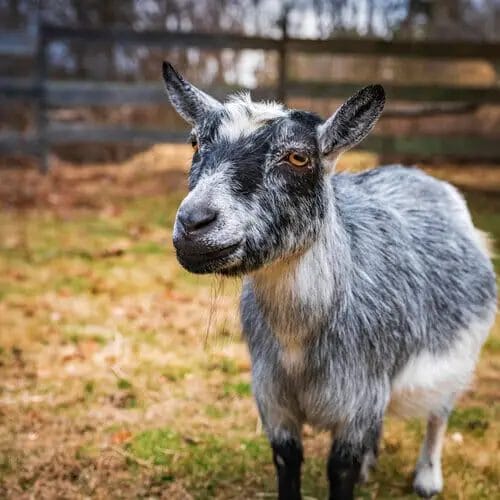
It originated from the west of Africa. This breed is also known as ‘Miniature Alpine’. They have a pretty proportionate body structure.
They are of medium length and have erect ears with short-medium hair. Any colors or, combinations are acceptable for this breed. Bucks are 23.5 inches whereas does are 22.5 inches.
Like the LaMancha breed, the goats of this breed are loveable and gentle. This breed is considered to be similar to a breed called ‘Pygmy’. But there are some differences between these two breeds which makes them two individual breeds.
In terms of milk, this breed is one of the best kinds. Cause their milk contains a great amount of butterfat and protein which is 6-10% higher than other goat milk. But the surprising matter is it gives pound milk a day with the same nutrition.
Oberhasli – Best Goat for High Quality Milk
- Known for: Modern American breed of dairy goat.
- Gestation Period: 148 to 153 days.
- Suitable For: Small farms & suitable commercial dairy farms.
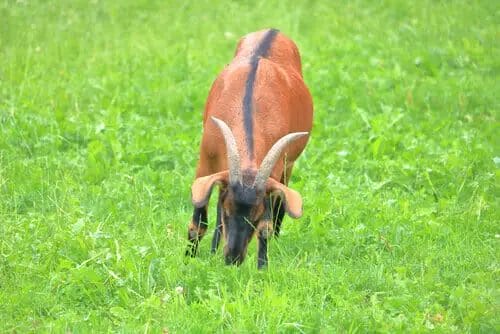
This breed is from Switzerland. The distinctive feature of this breed is a straight nose, upright ears, and large eyes. This breed is well known internationally and is native to Switzerland. However, they have been imported to the USA in 1906 and in 1920.
They are medium-sized and chamois colored. The height of the bucks is 30-34 and the does are 28-32 inches with 100-150 pounds of weight. Their forehead, legs, belly, and udder are fully black. Further than that their whiskers, lower chest, head, and back have a black overlay too.
Also, there are black stripes on the other parts of the body. The goats of this breed are calm, alert, and friendly in behavior. The does are a great source of milk. Another amazing thing about this breed is they’re less fearful of water whereas other breeds can easily get ill from a little humid weather.
Pygmy Goat- Best For Meat, Profitable for Breed for Commercial Farms
- Known for: American Pygmy is reared for meat or as a companion animal.
- Gestation Period: 145 to 155 days.
- Suitable For: Small farms & suitable commercial meat farms.

This type originated in Africa and is also known as ‘Cameroon Dwarf Goat’. They have a thick body structure. All body colors are acceptable for this kind. They have short medium hair.
The density of the hair varies in different climates. Bucks grow a long beard at a certain age which is absent in does. Bucks weigh 50-70 pounds with a height of 16-23 inches. On the other side, does weighs 40 to 70 pounds with a height of 16 to 22 inches.
This breed is mainly raised for meat but can provide nutritious milk for a short period. For their lovable look, some people also nurture them as pets. Even though their milking period is short their milk contains 4.5% to 11% butterfat.
Kiko Goat- Best for Meat
This type was derived from New Zealand. They are mainly raised for meat. This breed can be medium to large in shape. They have a strong head, alert eyes, and erect ears. Their primary color is white but any other color is accepted in this breed. But for does, the ears are not that erect and pendulous. Also, the does are good mothers.
Their neck is proportional to their body and has long legs. They have straight horns over their head. Their tails are vertical too. Kiko is mainly characterized by its hardiness.
They are parasite resistant and can tolerate rustic conditions which is why they have great survivability. As they are aggressive foragers this will help you to clean up your weeds. As this breed has a rapid growth rate it is a good pick if you are focusing on meat.
Saanen – Profitable Milk Goat
Like Oberhasli, this breed also originated in Switzerland. Saanens are white or light cream. They have erect ears with short hair. They can be large or, medium-sized. Bucks are 32 inches tall and 160 pounds in weight. Does weighs 135 pounds and is 30 inches tall.
This breed is known to be the largest dairy goat breed. They’re adaptable to various types of climates and are easy-going. Also, they have an adorable look. Their milk has 3-4% fat and is second in milk production after Alpine goats.
Toggenburg – Best Dairy Goat
This breed was derived from the valley of Toggenburg in Switzerland. Mainly they were named after the place they originated from. This medium-sized breed has erect white ears carried forward.
Their hair can be short or long. Bucks are 28 inches in the withers with a weight of 145 pounds whereas does are 120 pounds in weight and 26 inches in the withers. They also have white spots on their body.
They are alert, stiff, and robust in their appearance. They have white legs with white triangles on each side of the tail. Toggenburg is also known as the oldest dairy goat. Even though they have 2-3% butterfat in their milk. Their milk is whiter and easily digestible than cow milk.
Spanish – Best Goat for Both Meat and Milk
The ancestry of this breed is unknown. But most of the goats from this breed are wild or semi-wild. Which gives them the advantage of great survivability. This breed can survive with minimal management and also without any human management.
As these goats are well-adapted survivors from the wild their horns, hair, shape of the ear, and body color is non-compatible. They are friendly and agile. They are extreme foragers and parasite resistant. They have a mediocre growth rate and size. Even if they are a great breed for meat they also provide a handsome amount of milk too.
Savanna Goat – Best for Meat and Milk
This breed originated from South Africa. They are well-muscled and have thick skin. With a great bone structure, they have pendulous ears, long necks, strong horns, and hooves. Bucks are of 200-250 pounds whereas does weigh 125 to 200 pounds. Pigmentation on their different limbs helps them from the UV rays of the sun. For having a strong jaw they are good foragers.
As they are from Africa they can adjust themselves to any weather and are hardy in nature. Does are great mothers and provide a handsome amount of milk. People choose savanna as meat providers cause they have a great growth rate and are highly fertile.
Also, the meat of this breed is really tender. The most beneficial part of this breed is they require less care. Cause they are from the wild where they survived without sufficient food and handling. Further, they are disease-resistant.
Sable – Top Dairy Goat for Profit
This medium-sized breed originated from another dairy breed named ‘Saanen’. They have erect ears pointed forward and short hair. With long legs, they have a straight face. They have various colors and patterns except for solid light cream or, white.
Sable does weigh approximately 145 pounds with 30 inches in the withers whereas the bucks have 32 inches or more in the withers. This breed has a similar milking ability as the Saanen. Sable are heavy milk producers and their milk contains 3-4% milk fat.
Although ‘Sable’ comes from the breed ‘Saanen’ if we verify above all Sable is better than Saanen. Because Saanen has white light-colored skin that doesn’t do well in the sunny climate. As a result at a time, they get affected by cancer.
But on the other side, Sable has darker skin and they don’t have to face the problem of cancer. So while choosing breeds most people choose ‘Sable’ over ‘Saanen’ in this case.
Considerations While Buying a Goat
Purchasing the proper meat goat will assist in the achievement of your effort. Let’s have a look at the important things that should be kept in mind while purchasing a market goat.
- There have been numerous breeds to pick from, the most common of which is the Boer. Spanish, Kiko, and Tennessee Fainting Goat are some of the many demanding breeds.
- Goats for a market project are often bought after they have been weaned by their mothers and maintained until they have been purchased.
- Check for rounded shoulders, broad forelegs, a deep twist, and a velvety feel across the ribs. Find an animal that positions its feet and legs appropriately at rest and while moving.
- The goat’s back must be very strong, with muscle through the top, behind the shoulders, and also in the front side of the hips, mostly through the brisket, forearm, and hindquarters.
- Check for a powerful breed head with such a straight type of jaw that is not overshot (like parrot mouth) or undershot (like monkey jaw).
Final Words
Now, this is the end of our list of best goats for milk and meat. Neither of these breeds is superior to others. However, they have some advantages and disadvantages.
However, when you’re going to select a breed to rear, be sure that it is profitable and easy to rare.
Need help or have any questions? Please comment below.

Want to go into the business and need training and mentoring
That’s a great idea. You should pick a goat breed first.
Thanks so much for the information.